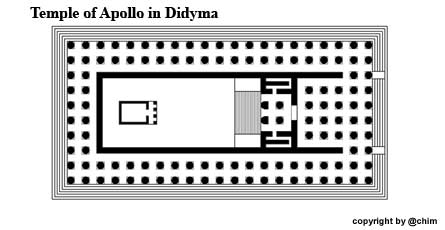 |
|
Ancient temples in Turkey Didyma |
||||||||||||||||||||
|
|
|
|||||||||||||||||||
|
||||||||||||||||||||
|
The large Hellenistic temple had two predecessors from archaic times. One building dates from around 700 B.C., the other from the 6th century B.C. Even then, the complex was given a ring hall supported by columns, the shape of which anticipated the Hellenistic sanctuary. Since the archaic sanctuary lies under the stone masses of the Hellenistic temple, relatively little is known about it. In the temple courtyard remains of the previous buildings can still be seen. The construction of the Hellenistic sanctuary began around 330 BC. Inside the temple there is a courtyard where the foundations of a building measuring 8,24 m × 14,23 m are located. This building served to protect the Kultmal, a freshwater spring. |
||||||||||||||||||||
| Apollo | ||||||||||||||||||||
|
In Greek and Roman mythology, Apollo is the god of light, healing, spring, moral purity and temperance, as well as prophecy and the arts, especially music, poetry and song; he was also the god of healing and the god of archery. Born in Didyma, the son of Zeus, the father of the gods, and Leto, the goddess (Latin: Latona), like his first-born twin sister Artemis (Latin: Diana), he belonged to the Olympic gods, the twelve main gods of the Greek pantheon. The sanctuary in Delphi, the most important oracle site of antiquity, was consecrated to him. |
||||||||||||||||||||
| The history of Didyma: | ||||||||||||||||||||
|
|
||||||||||||||||||||
|
|
||||||||||||||||||||
|
|
||||||||||||||||||||
|
|
||||||||||||||||||||
|
|
||||||||||||||||||||
|
Tunnel corridor into the inner courtyard |
||||||||||||||||||||
|
|
||||||||||||||||||||
|
|
||||||||||||||||||||
|
|
||||||||||||||||||||
|
|
||||||||||||||||||||
| Half column Cult hall | ||||||||||||||||||||
|
|
||||||||||||||||||||
|
|
||||||||||||||||||||
|
|
||||||||||||||||||||
|
|
||||||||||||||||||||
| The world-famous Medusa head from the temple frieze | ||||||||||||||||||||
| Photos: @chim, Monika P. | ||||||||||||||||||||
| Translation aid: www.DeepL.com/Translator | ||||||||||||||||||||
| Source: Wikipedia and others | ||||||||||||||||||||
|
|



